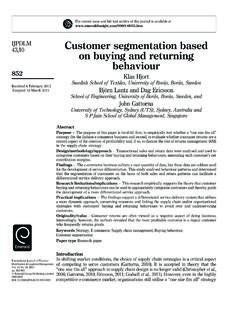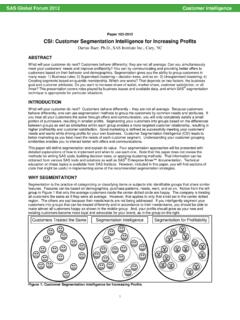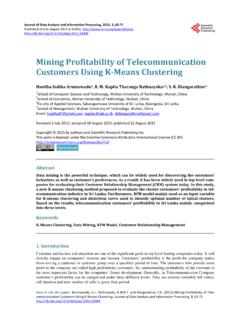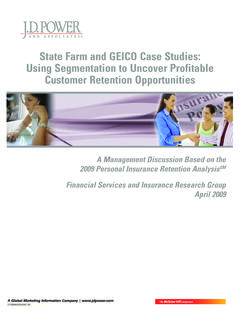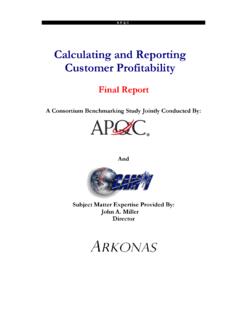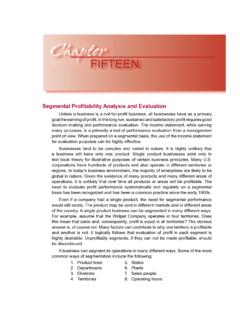Transcription of CUSTOMER SEGMENTATION BASED ON BUYING AND …
1 509 CUSTOMER SEGMENTATION BASED ON BUYING AND RETURNINGBEHAVIOUR: supporting differentiated SERVICE delivery INFASHION E-COMMERCE*KHjortSwedish School of Textiles, University of Bor sBLantz,DEricssonSchool of Engineering, University of Bor of Technology, Sydney (UTS);Sydney, supply chains and organisational strategies in the fast-moving consumer goodsbusiness, especially within fashion e-commerce, requires a profound understanding ofcustomer behaviour and requirements. The purpose of this paper is twofold: firstly, toempirically test and support whether a one size fits all strategy really fits all in thefashion e-commerce business. Secondly, this study aims to evaluate whether consumerreturns are a central part in the creation of profitability, and if so, the role of returnsmanagement in the overall supply chain strategyRESEARCH APPROACH:Historically, customersegmentation BASED on BUYING behaviour lacks empirical evidenceto support its usefulness(Godsellet al.)
2 , 2011).Thisstudywasconductedincollaborati onwith , a Nordic e-commerce site that specialises in fashion and sales and return data from a two-year period were analyzed. Data from fourmarkets was used to categorize customers BASED on their BUYING and returning behaviourand investigated according to each CUSTOMER s net contribution to the AND ORIGINALITY:In theory, SEGMENTATION BASED on the CUSTOMER s BUYING behaviour should be performedusing point of sales data or a more qualitatively BASED understanding(Gattorna, 2010).Inthe fast-moving business of e-commerce, CUSTOMER returns are a valuable return management is not effectively used, returns often decreaseprofitability. The e-commerce business collects and stores vast amounts of data; yet, this wealth ofinformation is seldom used in developing service differentiation. Organisations often offerthe same level of service to all customers irrespective of eachcustomer s net this study, behaviour patterns were analysed, and it was determined that groupingcustomers BASED on both sales and return patterns facilitates a differentiated servicedelivery approach.
3 It enables the company to offer different delivery and return conditionsto specific customers in order to increase their net contribution. Interestingly, we foundthat the most profitable CUSTOMER is the repeat CUSTOMER who frequently returns IMPACT:The research reportedin this paper empirically supports the theory that CUSTOMER buyingand returning behaviour could be used to categorize customers in order to guide a more510differentiated approach. However, to create a deeper understanding of the requirementsfor each CUSTOMER group, future and more qualitatively oriented research is IMPACT:The main purpose for differentiating service delivery levels is related to the problem ofover and underservicing when using a one size fits all approach(Gattorna, 2006).Ourfindings support and suggest the implementation of service delivery BASED on a moredynamic approach that nurtures resourcesand links the supply chain and/ororganisational strategies with categorized CUSTOMER BUYING and returning :Strategy, CUSTOMER SEGMENTATION , Differentiation, E-Commerce, BuyingBehaviour, Supply Chain ManagementPaper type:Research paperINTRODUCTIONIn shifting market conditions, the choice of supply chain strategies is critical whencompeting to serve customers (Gattorna, 2010).
4 It is accepted in theory that the one sizefits all approach to supply chain design is no longer valid(Christopheretal.,2006;Gattorna, 2010;Ericsson, 2011;Godselletal.,2011).Stillorganisatio ns,eveninthehighly competitive e-commerce market, utilise a one size fits all strategy to create anddeliver value to their consumers, thereby implicitly assuming that consumers' demandsand BUYING behaviour are homogeneous, and therefore, there is no profitable reason todifferentiate delivery in terms of , e-commerce consumers' BUYING behaviour is not homogenous, especially in thefast-moving consumer goods (FMCG) business. FMCG organisations compete not only inproducts and price, but also in a large variety of services . For example, accessibility andspeedy delivery are critical determinants for success. Returns management (RM) is clearlyapartoftheparcel,and,ifhandledpro perly,itcandecreasecosts,whilesimultaneo uslyincreasing revenue and serving as a means of competition.
5 The total offer is called the value package and consists of the physical product plus the services surrounding of these services are the order qualifiers, and some are the order winners(Ericsson,2011).If CUSTOMER groups exist with different service requirements, then it makes sense to try tomatch these with differentiated supply chain strategies (Godsell et al., 2011). Gattorna(2010)argues that organisations, or rather supply chains, need not only to understandthe competitive forces, they need also to understand theircustomers' BUYING , they need to understand how to use the knowledge internally to offer anddeliver suitable value propositions. In e-commerce this has implications on servicedelivery as well as the sourcing of products and thus onhow we design the supply designing supply chains, Godsell et al.(2006)express a need to replace the focus fromthe product to the end- CUSTOMER and specifically on the end- CUSTOMER s BUYING there are twodifferent schools of thought in supply chain design(Godsell etal.)
6 , 2011).Thefirsttheoryisthelean-agile supply chain design, which is product second school of thought is that strategic alignment is driven by CUSTOMER buyingbehaviour. Both schools take a supply chain approach; thus, neither theory focuses on theconsumer or the end-user as is done in this chains are omnipresent(Gattorna, 2010),ande-commerce organisations exist inmany supply chains or supply networks. As noted earlier, it is accepted that the one sizefits all approach to supply chaindesign is no longer valid, and the suggested number ofparallel supply chains varies and is naturally context dependent. It depends upon diversevariables such as demand uncertainties, product characteristics, replenishment lead-511times, s perspective, trying to link the supply side with the demand side, often withaproductfocus(seeCroxtonet al., 2001;Christopheret al., 2006). In e-commerce, thefocus would naturally shift to the e-commerce organisation, which changes the focus frommanufacturing towards sourcing of and delivery of finished goods.
7 However, as e-commerce organisations grow, they are likely to try to design and produce their ownproducts and brands in search of greater margins, which shifts the focusback towardsmanufacturing or at least a combination of sourcing and manufacturing. This exemplifiesthe need for at least two supply chains, probably even more. In e-commerce, the criticalfocal point is to match the demand from consumers with an appropriate set up ofsourcing, final distribution and returns-handling activities. If demand variations fordifferent products exist, it is probably useful to apply diverse sourcing strategies in orderto match demand uncertainties with responsive supply strategies. Gattorna (2010) arguesthat in a typical supply chain three to four dominating CUSTOMER BUYING behaviours existthat need to be understood in detail. Further, these dominating behaviours coverapproximately 80% of the customers, and the same dominatingpatternsfitothermarketsas et al.
8 (2011)explain the need for combining both product characteristics andmarket considerations when designing supply chain capabilities and selecting supply chainpipelines. In the selection of pipeline typesthere are eight theoretical types to choosefrom depending on whether products are standard or special, demand is stable or volatileand lastly if the replenishment lead-time is short or long (Christopher et al., 2006).According to Christopher et al. (2006), standard products tend to be more stable indemand with longer life cycles, whilst special products tend to be the opposite, erraticdemand and shorter life cycles. Therefore, there is a connection between demandpredictability and product characteristics, which reduces the amount of theoretical pipelinetypes to four (Christopher et al., 2006, p. 282). Depending on product demand and supplycharacteristics, Christopher addresses a lean, agile or a combination of the two, aleagileapproach (see Christopher et al.)
9 , 2006, p. 283).In many markets, especially the e-commerce market where several organisations arecompeting, selling the same brand or similar products with little or no difference inprice, it is difficult to maintain a competitive edge trough the product itself(Christopher,2005).Therefore, the service level and the delivery service as such becomes a criticaldeterminant for market success. The e-commerce supply chain often appears, in theoryand practice, as a one-dimensional chain. However, in reality, it is a spaghetti bowl ofinterrelated activities or processes sourcing thousands of SKU s, receiving, storing,picking, packing and distributing them to the end user and later receiving and handlingconsumer returns. In the e-commerce business, especially in fashion, delivery from stocktoconsumers makes it difficult to apply the lean/agile approach for the final , customers BUYING and returning behaviour might affect the profitability if it isnot matched with a suitable delivery and return the fashion e-commerce business, a trend towards more liberalised delivery and returnconditions as a way to cope with competition inside the industry has become , these lenient return policies attract new consumers from the traditional retailchains.
10 Consequently, return policies are a part of marketing practice(Autry, 2005),andtherefore returns management (RM) is surely a part of the value creation process. RM isthe part of supply chain management that includes returns, reverse logistics, gatekeepingand avoidance(Rogersetal.,2002, ). Mollenkopf et al.(2011)investigate themarketing/logistics relationship relative to RM. They found that the effectiveness of RMwas enhanced when firms coordinated their strategic and operational activities. Clearly RMneeds to be efficient; in some cases, however, it seems that it is also a part of the valuecreation not only the value recovery. Stock (2009) emphasises that product returns will512continue to be a part of business operations, and literature indicates that competition isincreasing and consumer demands are surely following this development. Therefore, thereis a need to align RM within the supply chain strategy where the whole supply chain needsto operate efficiently and effectively and returns are no exception (Stock, 2009).

